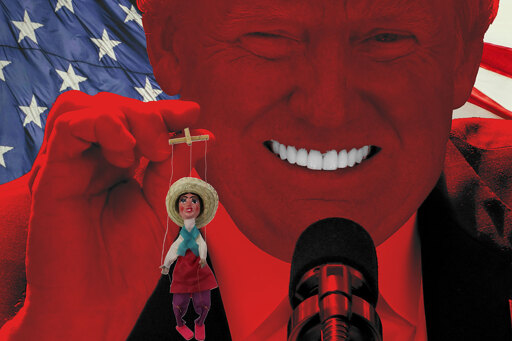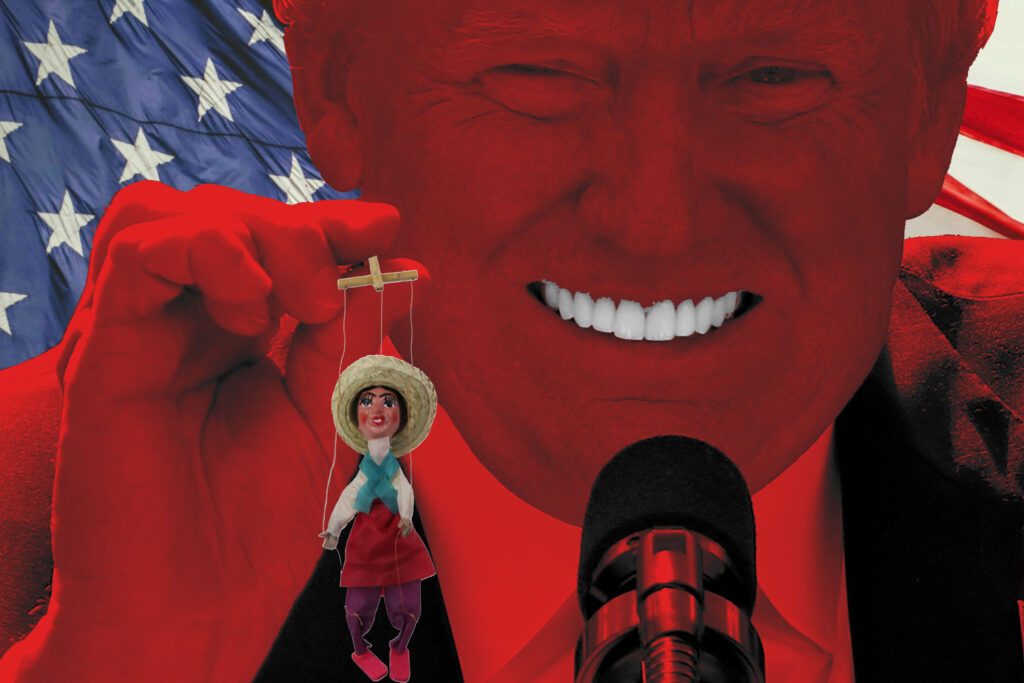This article by Viri Ríos originally appeared in the October 30, 2025 edition of El País. The views expressed in this article are the author’s own and do not necessarily reflect those of Mexico Solidarity Media*, or the Mexico Solidarity Project.*
“Mexico is nobody’s piñata. Mexico deserves respect,” declared [Mexican President] Claudia Sheinbaum on Wednesday, visibly irritated, after her latest clash with Donald Trump. The forcefulness of her words contrasted sharply with her usual composure and seemed disproportionate to the cause of the conflict: the cancellation of 13 air routes by the U.S. government.
Therefore, to understand the true weight of his statement, it is necessary to look beyond the aeronautical disagreement and observe how, in recent months, Trump has exerted constant and, in more than one sense, humiliating pressure on Mexico, through a list of demands.
I had access to it and, as far as I could see, it extends over several pages.
My conclusion, after reviewing the document, is that Trump is not simply seeking to renegotiate a trade agreement with Mexico, but rather to use this dialogue as an ideal scenario to force our country to make decisions contrary to our interests.
The central demand is the complete alignment of Mexico with the economic interests of the United States. Trump proposes obtaining the power to block investments, impose conditions, or demand modifications to projects coming to Mexico.
Trump doesn’t want Mexico to be a trading partner. He wants Mexico to be a cheap, subservient producer, colonized by American companies that enjoy regulatory and structural advantages. Nor does he want a Mexico capable of implementing industrial policies that benefit Mexican businesses.
In the list of demands from the United States to Mexico, only a few address truly bilateral or mutually beneficial issues. The majority are demands aimed at forcing Mexico to modify its regulatory framework to favor U.S. companies or pave the way for them to dominate our market and weaken national competitiveness.
The central demand is the complete alignment of Mexico with the economic interests of the United States. For example, Trump proposes obtaining the power to block investments, impose conditions, or demand modifications to projects coming to Mexico, whenever his government deems them a risk. This would be achieved through the de facto replacement of the National Foreign Investment Commission, a Mexican inter-ministerial body, with directives issued by the Committee on Foreign Investment in the United States (CFIUS).
Our neighbor to the north is also demanding that we align our export policies with theirs in order to prohibit the use of certain technologies such as Logink (a Chinese logistics management platform) and Huawei (a Chinese telecommunications infrastructure provider). At the same time, they are seeking detailed information from Mexico about the origin of its steel imports, so that we can be sanctioned if we acquire materials from countries that are unfriendly to the United States.

The U.S. government is also asking Mexico to resolve specific issues in favor of its companies. For example, they want Mexican authorities to rule in favor of Vulcan Materials, a company seeking millions in compensation, arguing that Mexico expropriated its land to create a protected natural area. They are also seeking an extension of the partial concession granted to IGY Marinas in Cabo San Lucas, which was revoked. In addition to these requests, there are a variety of other issues, including expediting the processing of visas for certain U.S. officials.
As if the above weren’t enough, the United States’ requests are accompanied by a series of explicit demands for the National Commission for Regulatory Improvement (CONAMER) and the Federal Commission for Protection against Sanitary Risks (COFEPRIS) to facilitate the entry of American products into Mexico. These demands include sanitary registrations, patents, and even the elimination of certain investment conditions previously imposed by the Mexican government.
Other requests are focused not on facilitating the entry of American companies, but on weakening Mexican ones. For example, they are requesting limitations on certain designations of origin and permission for the entry of biotech corn that could destroy native varieties.
There is a greater interest from Mexican officials in ending negotiations without friction than in protecting national interests.
Trump is also demanding strict measures to regulate manufacturing, protect marine life in fishing grounds, and protect flora in avocado-growing areas. While these measures appear to be aimed at environmental protection, the question remains whether they are simply a way to reduce the competitiveness of Mexican industry by imposing higher standards than those followed by our competitors.
Mexico is already agreeing to do many of the things the United States proposes, whether out of fear or a lack of foresight. Some officials see the demands as positive for free trade or even fair to international businesses. They seem unaware that by accepting them, Mexico is closing itself off to the possibility of implementing an investment policy that truly benefits us and is ultimately limiting our own growth.
The problem lies in the fact that, frequently, among the Mexican officials in charge of the negotiation, there is a greater interest in ending the negotiations without friction than in protecting national interests.
If Mexico continues to comply with Trump’s list, there will be two victims. In the short term, the first will be Mexican businesses, which will find no protection or support to compete with the American companies that will arrive and dominate the market. The second victim will be the Sheinbaum administration, which will lose its ability to grow the economy for the benefit of Mexicans.
Trump’s interventionism has already succeeded in imposing an ideologically aligned government in Argentina, and it cannot be ruled out that, if this path continues, it will eventually achieve the same in Mexico. The US president pressed the right button in Argentina: he played on the enormous fear the Argentine people have of a new currency crisis, and he won.
In Mexico, Trump is also pressing the right button: gradually weakening the Mexican economy through regulatory adjustments that stifle its growth. Once that’s done, the United States will be able to launch corruption charges against high-ranking Mexican politicians, as it has done in Colombia, and achieve a relatively quick change of government.
Mexico must be vigilant. Of course, confronting Trump is a risk, but in the long run, not doing so could be even riskier. If the US President’s satisfaction depends on Mexico granting him everything, our country isn’t protecting the bilateral relationship; it’s sealing the political fate of his leftist government.
What Trump Really Wants from Mexico
October 30, 2025
If Mexico continues to comply with Trump’s demands, there will be two victims: Mexican businesses, which will find no protection or support to compete with the American corporations, & the Sheinbaum administration, which won’t be able to manage the economy to benefit Mexicans.
People’s Mañanera October 30
October 30, 2025October 30, 2025
President Sheinbaum’s daily press conference, with comments on Oaxacan Isthmus train, Simón Levy arrest, Christopher Landau comments, FIFA tax exemptions, Navy law, and Emmanuel Macron visit.
Morena: From a Movement to Leading a Nation
October 30, 2025October 30, 2025
An interview with Morena dissident Javier Bravo.
The post What Trump Really Wants from Mexico appeared first on Mexico Solidarity Media.
From Mexico Solidarity Media via this RSS feed





